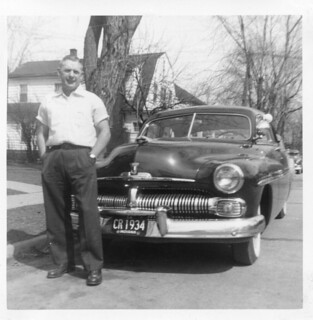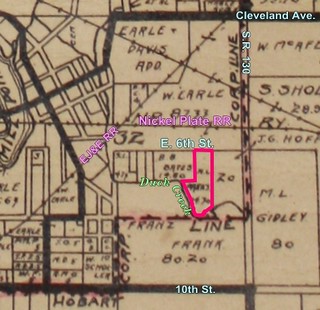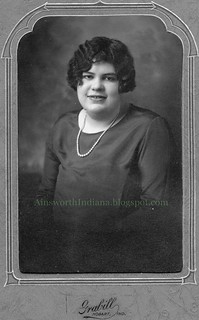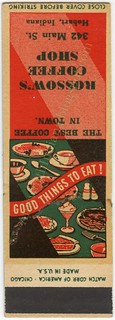 (Click on image to enlarge)
(Click on image to enlarge)
Image courtesy of Eldon Harms.
Eldon Harms
April 1, 1924 — April 18, 2016
The photo above was taken on April 1, 1954 — Eldon's 30th birthday. It shows him standing in front of his 1950 Mercury, his favorite car. "Dummy me," he once said, "I traded it in for a 1954 model because I just had to have the new thing. I wish I'd kept that 1950 Mercury. That was the best car." And he'd had plenty of other cars in his lifetime, to judge by.
We encountered this photo in the last album we looked through together, Eldon and I, just last month. Over the course of the few years I've known him, we'd been through nearly all the photos he had, but this album was up on a high shelf in a closet, and we hadn't found it before. The album began with photos from the early days of his marriage, before he and Norma owned a house or had children. I found those photos so touching — just a young couple on their own together, free to do as they pleased; one who loved to drive, one a happy traveling companion … and hundreds of miles of open road. They drove all over the country on vacations. Aside from the usual attractions, they visited the shore of Lake Michigan on a winter's day and photographed each other standing on the shelf ice. "You aren't supposed to do that," Eldon said, mock-shamefaced, as we looked at those pictures. "It's too dangerous." But there was Norma, snappily dressed in a skirt suit and high heels, risking her life with a beaming smile. The album (arranged in chronological order, like all his albums) goes on to show the old
John and Sophie Harms place as it looked when Eldon and Norma bought it "on a promise and a prayer," as he said. There are photos of what looked to be a
very fun housewarming party. And then photos of their baby daughters.
I wish I had met Norma, but I never had that opportunity. She died in 2005, before I started my historical research, and it was this blog that led me to contact Eldon in 2010. A former co-worker of his at NIPSCO happened across the blog, saw Eldon's name as my guess at the identity of the
"Harms boy" who'd seen Henry Nolte's murderer, went to ask him about it and (to his surprise, since Eldon had never mentioned the murder in all the years they'd worked together) got an earful. That same co-worker tracked me down and told me I should talk to Eldon. "Maybe I will," I said. Thank goodness I did. He became a wonderful source of historical information and material.
Eldon had an interesting range of experiences in the Ainsworth/Hobart area. He grew up on a farm where the plowing and harvesting was done with teams of horses; where his parents produced molasses from their own sorghum and apple butter from their own orchard; where the light came from kerosene lamps and the water from a windmill. His family never had electricity until he was about fourteen. Eldon had broken in a team of young horses in the field where Big Maple Lake is now; he had plowed with a tractor where Veteran's Memorial Park is now. As a high-school student, he earned money for textbooks and a suit of clothes by tending the 2,000 hens at the poultry farm run on the
old Chester place. He was lawn-mower and driver to
John Dorman. He worked with his father in Hobart's historic old mill, and years later was able to tell me the location and function of the various buildings in the
mill complex. He also worked at the Wheeler mill. Eventually he settled on a career with NIPSCO.
He had a knack for describing people as they appeared to him. Mr. Roper, one of the partners who ran Hobart's old mill, was kind but peremptory: hearing of a school holiday, he showed up at the Harms farm and asked Eldon: "What are you doing while the schools are closed?" and when Eldon replied, "Nothing," said, "You're coming to work for me." John Dorman was a "grand old man," involved in everything that the high society of Hobart did, exacting and careful of his own dignity.
Gust Lindborg, presented with the challenge of a broken piece of machinery, would become lost in studying it, while Eldon quietly saw himself out of the shop, knowing that Gust needed and wanted no help and would get the job done.
Jack Hendrix, a professional musician, responded sharply to Eldon's question about when he would "start" a particular engagement: "I
open on such-and-such a date." ("He educated me," Eldon said with a laugh.)
Through him I got to meet so many of the Ainsworth people I've talked about in the blog, and the farm animals and machinery, and the cars. When we (his home health aide and I) were looking at old pictures with him, we sometimes had to laugh at the way, at each turn of the page to a new picture, Eldon's eyes would go straight to any car in it, and he would announce, "That's a Studebaker," or "That's a Ford V-8," or "That's a 1958 Desoto," before he'd say a word about any people in the photo.
Eldon did have a home health aide in the last few months of his life. He was not allowed to drive, and practically housebound. For someone who had always been active, hard-working, and self-reliant, that must have been difficult. Eldon liked to quote his mother's saying: "Growing old is not for sissies." He found out the truth of that. And I don't mean just the physical infirmities of old age. There was one statement I heard over and over as Eldon talked to me about the people of Ainsworth and Hobart: "He's dead," "She's dead." Sometimes he would just throw up his hands and say, "Everybody's dead!" I once said to him, "That's the problem with life: you either have to die, or stand around and watch everybody else die. And I don't know which is worse." "I don't either," he said. He and Norma used to clip the obituaries of their relatives and friends until the task became overwhelming. And finally, Eldon told me, there came a day when he had to miss a friend's funeral to attend Norma's.
It sounds awfully depressing, doesn't it? And yet, during the many hours I spent with him over the years, he was nearly always cheerful — laughing, joking, making fun of himself — interested in the world, interested in other people. Though I began spending time with him just to learn about Ainsworth, eventually I spent time with him just because he was good company.
And so, as a friend, he will be greatly missed. As living history, he is irreplaceable. The title of this post is another favorite phrase that his mother and father used to describe an event that meant things would never be the same again: "It's the end of an era." That phrase had come to mind, Eldon said, the night he watched the old mill in Hobart burn. And now it comes to my mind. Eldon has gone, and taken Ainsworth with him.
I wish him rest, and if there are happy reunions beyond this life, he is having plenty of them.




































